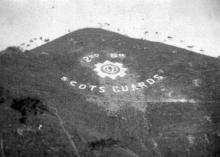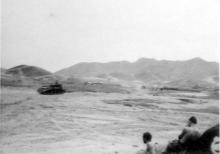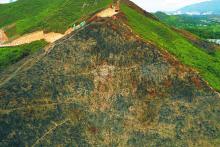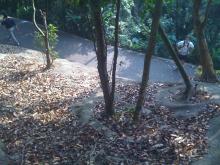Tai Shek Mo / Crest Hill [????- ]
Primary tabs
Submitted by Unknown user (not verified) on Mon, 2011-02-14 14:51
The closest place to Shenzen that is outside of the restricted area. Used to be used by the British military for listening/watching as well as for exercises.
Can be reached via roads or more interestingly by a short hike from Ho Sheung Heung.
Some old pictures: http://www.4regtra-reunion.org.uk/16005.html
Some new pictures: http://www.tripntale.com/trip/4839/ho-sheung-heung-hong-kong-20080106-tr...





Comments
re: Tai Shek Mo / Crest Hill
Thanks for posting - I didn't realise we could get this close to the border. Somewhere to add to the list of places to go hiking.
Regards, David
Re: Tai Shek Mo / Crest Hill
Hi there,
I had been wondering about the warning sign and the red flag..... Unfortunately I did not find a way to zoom in to have a closer look.
There were barb wires in one of the photos too.
Best Regards,
T
Although the sign is
Although the sign is ominious, everyone just ignores it :-)
Its a relatively short hike but well worth it. The views are just amazing. While walking, you see the entire Shenzen rise up in front of you....
For anyone interested, here are the breadcrumbs to get there:
http://www.everytrail.com/view_trip.php?trip_id=826803
TB
Re: Warning sign and red flag @Tai Shek Mo / Crest Hill
Hi there,
I managed to copy the mage and blow it up to 200% and was able to read the Chinese charactors. Further digging revealed it concerns the Lo Wu Firing Ground down below. If there is target practice in progress the red flag would be raised.
Anyway.......
Best Regards,
T
*smile* The red flag is
*smile*
The red flag is there 100% of the time, but as I said, people just ignore the warning and keep going:
http://good-times.webshots.com/photo/2018160100089478073DyYuxo
Observing the new People's Republic in 1950
As a young national serviceman, I arrived at Lo Wu camp early in February 1950 with the 15 Observation Battery of the Royal Artillery. As there was then no rail traffic across the border with China, after disembarking from our troopship we took the steam train from Kowloon to its then terminus at Fanling, from where we were ferried by truck from from Fanling Station to occupy a tented camp below Crest Hill on the New Territories side.
One of the periodic duties was to climbCrest Hill by a zig-zig path to the observation post at the summit, which lay behind the figures in the photographs. The post was merely a slit trench at that time, although later upgraded to a concrete pill-box of which the remains seem to be still there. When observation duty came round, each new party had to carry supplies for the few days of their observation. A jerry-can of water on our backs on a carrying frame caused us to lurch dangerously close to falling back down the hill.
There was little to report during my spells of observation. The landscape was largely of paddy fields, although a barracks of the People's Army lay alongside the line of the empty tracks disappearing towards Canton. Although refugees or smugglers would swim the river, the Hong Kong police had apparently little interest in our reports.The only sign I saw of any military activity was a soldier sitting on a doorstep of the barracks, which was probably the target of the Mitchell bomber of the Koumintang which on the morning of our first parade at Lo Wu flew in from Formosa above our heads, dropping a bomb before quickly fleeing back through Hong Kong airspace. It perhaps may have been as well that Spitfires from Kai Tak arrived too late to engage with the encroaching aircraft. I have no idea whether either the British or Chinese governments made any protest.
My unit joined the UN forces in Korea later in 1950, by which time I had returned to Britain at the end of my service. I did not visit Hong Kong again until 1990, by which time Lo Wu camp had become a detention centre for boat people. I chose not to climb Crest Hill again because having survivred in 1950 I did not wish to be shot within the area of the red flags of the firing range. However, I was able to cross into the metropolis which had replaced the landscape of paddy fields of forty years before. I looked back at Crest Hill and at the summit from which I had last seen China.
Crest Hill
back in 2014 there was a hill fire there which revealed a stone emblem from the 2nd Battalion Scots Guards. Can any ex-serviceman confirm the history behind leaving these stone made battalion/regiment emblems on the surrounding hillsides. I find them quite fascinating.
Example picture: http://www.hkhikers.com/images/Tai%20Shek%20Mo%202014/Tai%20Shek%20Mo%20...
Re: Crest Hill Stone Emblem
The Guards Magazine as noted here mentions the stone emblem has been in place since 1927. The Scots Guards were based in Hong Kong for 15 months between 1927 and 1928 before leaving for Shanghai.
Scots guards
Thanks moddsey, I had no idea it was so old. I have an aerial picture from the early 70's that showed it as still quite bright. I know it's not the only one though and it appears that this kind of hillside artwork was popular amongst the various units stationed here.
Crest possibly under threat by government construction works
It's been reported by Apple Daily yesterday (22/11/2020) that government construction works have been commenced within proximity of the crest, with parts of it being marked by construction crews with red flags.
According to the news article (https://hk.appledaily.com/local/20201122/UC5SQVM55VAIXNE2IGVM7JBDCE/, in Chinese), the construction work is intended for a planned reservoir and its connecting roads as part of the Kwu Tung North New Development project. Upon inquiry, the Civil Engineering and Development Dept replied that they were aware of the crest and has notified their contractors to be mindful of the site, but have not made any changes to construction site boundaries which still overlaps with the crest (see image below, red pin indicates the crest while the red dotted line is the site boundary).
In the news article, Peter Li of the Conservation Association remarked that the construction site boundaries should not have included the crest in the first place, as the location for the planned reservoir is on the other side of the mountain, and expressed concern over the government's attitude in conserving historical artefacts from the Colonial era.